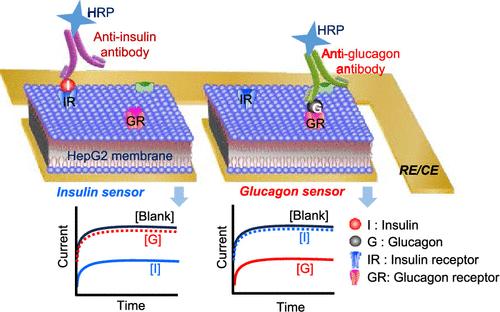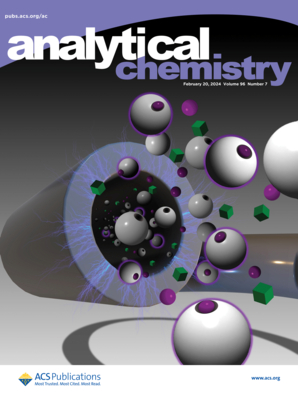Biomimetic Cell Membrane Layers for the Detection of Insulin and Glucagon
IF 6.7
1区 化学
Q1 CHEMISTRY, ANALYTICAL
引用次数: 0
Abstract
The growing need for reliable and rapid insulin testing to enhance glycemic management has spurred intensive exploration of new insulin-binding bioreceptors and innovative biosensing platforms for detecting this hormone, along with glucagon, in biological samples. Here, by leveraging the native protein receptors on the HepG2 cell membrane, we construct a simple and chemical-free biomimetic molecular recognition layer for the detection of insulin and glucagon. Unlike traditional affinity sensors, which require lengthy surface modifications on the electrochemical transducers and use of two different capture antibodies to recognize each analyte, this new biomimetic sensing strategy employs a simple drop-casting of a natural cell membrane recognition layer onto the electrochemical transducer. This approach allows for the concurrent capture and detection of both insulin and glucagon. We investigate the presence of insulin and glucagon receptors on the HepG2 cell membrane and demonstrate its multiplexing bioelectronic sensing capabilities through the binding of the captured insulin and glucagon to enzyme-tagged signaling antibodies. This new molecular recognition layer offers highly sensitive simultaneous detection of insulin and glucagon under decentralized conditions, holding considerable promise for the management of diabetes and the development of diverse biomimetic diagnostic platforms.

用于胰岛素和胰高血糖素检测的仿生细胞膜层
对可靠、快速的胰岛素检测以加强血糖管理的需求日益增长,促使人们深入探索新的胰岛素结合生物受体和创新的生物传感平台,以检测生物样品中的这种激素和胰高血糖素。本研究利用HepG2细胞膜上的天然蛋白受体,构建了一种简单且无化学成分的仿生分子识别层,用于检测胰岛素和胰高血糖素。传统的亲和传感器需要对电化学换能器进行长时间的表面修饰,并使用两种不同的捕获抗体来识别每种分析物,而这种新的仿生传感策略采用简单的将天然细胞膜识别层滴铸到电化学换能器上。这种方法允许同时捕获和检测胰岛素和胰高血糖素。我们研究了HepG2细胞膜上胰岛素和胰高血糖素受体的存在,并通过将捕获的胰岛素和胰高血糖素与酶标记的信号抗体结合,证明了其多路生物电子传感能力。这种新的分子识别层提供了在分散条件下高度敏感的胰岛素和胰高血糖素的同时检测,对糖尿病的管理和各种仿生诊断平台的发展具有相当大的前景。
本文章由计算机程序翻译,如有差异,请以英文原文为准。
求助全文
约1分钟内获得全文
求助全文
来源期刊

Analytical Chemistry
化学-分析化学
CiteScore
12.10
自引率
12.20%
发文量
1949
审稿时长
1.4 months
期刊介绍:
Analytical Chemistry, a peer-reviewed research journal, focuses on disseminating new and original knowledge across all branches of analytical chemistry. Fundamental articles may explore general principles of chemical measurement science and need not directly address existing or potential analytical methodology. They can be entirely theoretical or report experimental results. Contributions may cover various phases of analytical operations, including sampling, bioanalysis, electrochemistry, mass spectrometry, microscale and nanoscale systems, environmental analysis, separations, spectroscopy, chemical reactions and selectivity, instrumentation, imaging, surface analysis, and data processing. Papers discussing known analytical methods should present a significant, original application of the method, a notable improvement, or results on an important analyte.
 求助内容:
求助内容: 应助结果提醒方式:
应助结果提醒方式:


